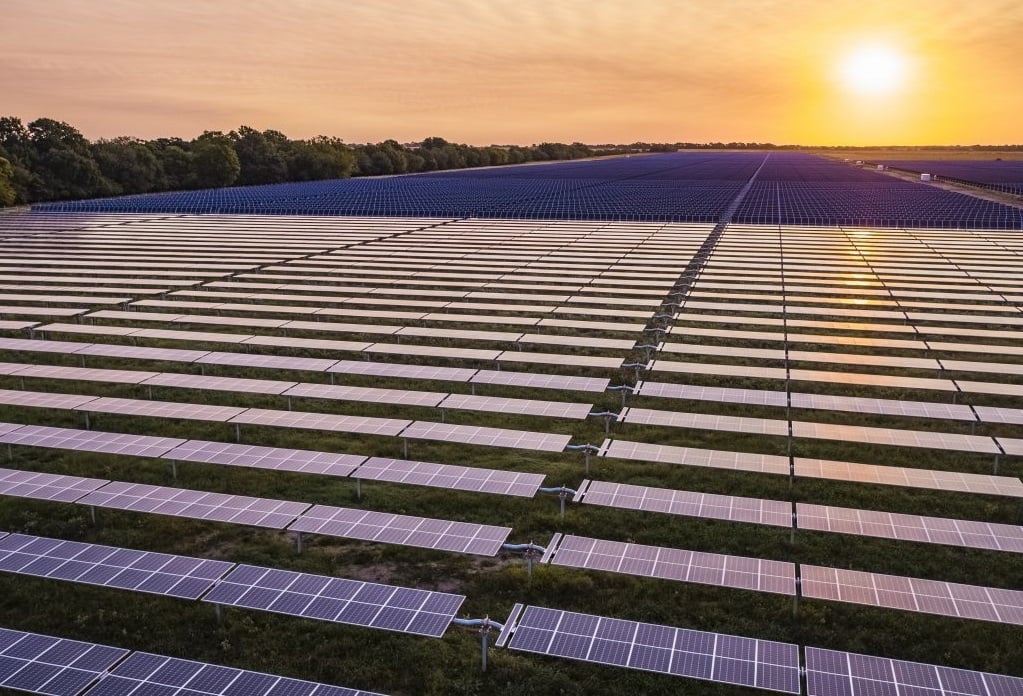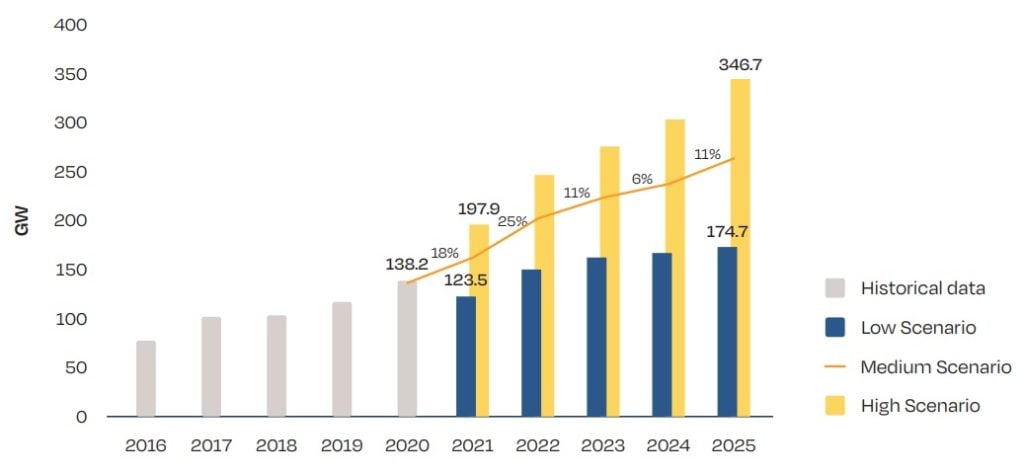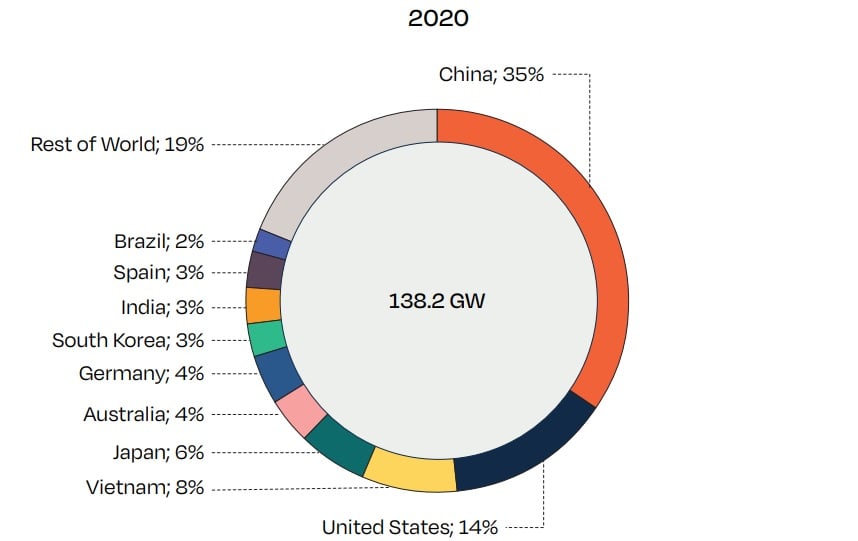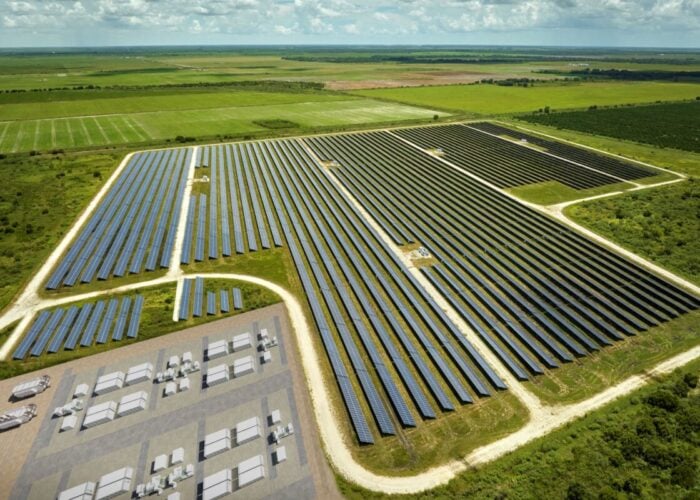
Higher-than-expected deployment figures last year have put the global solar sector comfortably within reach of the terawatt scale in 2022, SolarPower Europe (SPE) has said in its Global Market Outlook report.
The trade association previously forecasted installation levels would decline 4% in 2020 due to the impact of COVID-19. However, thanks in part to the technology’s cost-competitiveness, a record 138.2GW of solar was deployed, representing an 18% increase on 2019, meaning more than a third of all power plants built around the world last year were solar.
Unlock unlimited access for 12 whole months of distinctive global analysis
Photovoltaics International is now included.
- Regular insight and analysis of the industry’s biggest developments
- In-depth interviews with the industry’s leading figures
- Unlimited digital access to the PV Tech Power journal catalogue
- Unlimited digital access to the Photovoltaics International journal catalogue
- Access to more than 1,000 technical papers
- Discounts on Solar Media’s portfolio of events, in-person and virtual
That installation figure is lower than BloombergNEF‘s 2020 solar deployment number of 141GW but higher than the 135GW put forward by the International Energy Agency.
SPE CEO Walburga Hemetsberger said that in a year defined by unpredictability, solar offered a sense of security and control, adding: “Last year, even the most optimistic market analysts were forecasting a market decline, and yet solar proved its resilience and unstoppable growth trajectory.”
In spite of challenges related to rising silicon prices in the first half of the year as well as the ongoing impacts from the pandemic, SPE’s medium scenario anticipates newly installed capacities will jump by a further 18% in 2021 to reach 163.2GW.
And for each year up to 2025, the trade association has considerably increased its solar deployment forecasts, with the sector set to cross the 200GW-per-year barrier in 2022 – just five years after the 100GW level was reached – taking cumulative global installs up to 1.1TW.

The Global Market Outlook, which is SPE’s flagship report, forecasts cumulative grid-connected solar power capacities to reach 1,870 GW by 2025, according to the most likely scenario. Under optimal conditions, there could be as much as 2,146GW by the end of 2025.
Although solar deployment continues to break records, the technology last year increased its total power generation share by half a percentage point to around 3.1%, with nearly 70% still coming from fossil fuel and nuclear.
Aristotelis Chantavas, president of SPE, said that a solar-powered future “is well on the way”, but to remain on this path, it is necessary to ensure the right permitting processes and regulatory frameworks are in place to support the sector.
2020’s leading solar markets
Representing more than a third of installs, the Chinese market excelled in 2020, SPE said, with deployment reaching 48.2GW – an increase of 60% on 2019’s figures and the country’s second-best year ever. Subsidy deadlines meant that almost half of Chinese solar installs were connected to the grid in December, as developers worked to avoid penalties for delays. SPE’s medium scenario forecasts the country will add more than 409GW between 2021 and 2025.
In second place was the US, which doubled its growth rate to 43% over 2019, resulting in 19.2GW of new installs. The utility-scale segment was said to account for almost the entire growth of the country’s solar sector, as rooftop deployment was affected by COVID-19.

Shooting up the ranking was Vietnam, which grew from having only 97MW of installed solar in 2018 to deploying 11.6GW last year, with the boom thanks to rooftop segment projects completed before an installation deadline for feed-in tariffs.
While India is aiming to reach 100GW of solar capacity by 2022, a 56% year-on-year decline in installs in 2020 meant the country deployed just 3.9GW, leading SPE to label the market a “major disappointment”. While the pandemic was the main constraining factor, the report said there continues to be the nagging issue of electricity distribution companies’ (Discoms) unwillingness to sign power sale agreements.
To build on 2020’s figures, Hemetsberger called for faster permitting as well as minimum requirements for rooftop installs. During a report presentation at the smarter E Europe Industry Days event, she said: “It is incredibly important to have support by governments in the recovery. And this is really absolutely needed to increase the pace and go faster to speed up solar deployment.”







